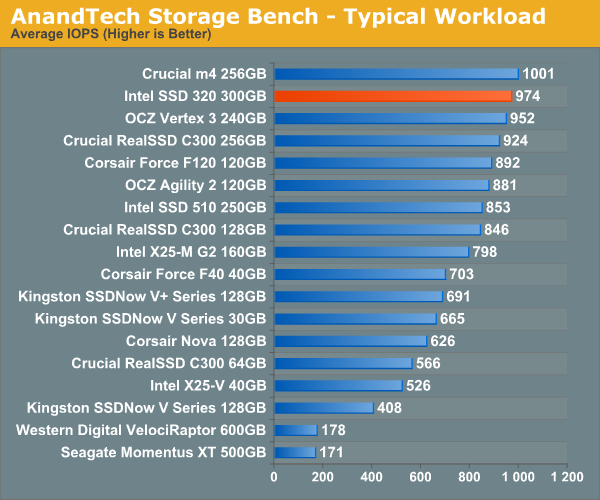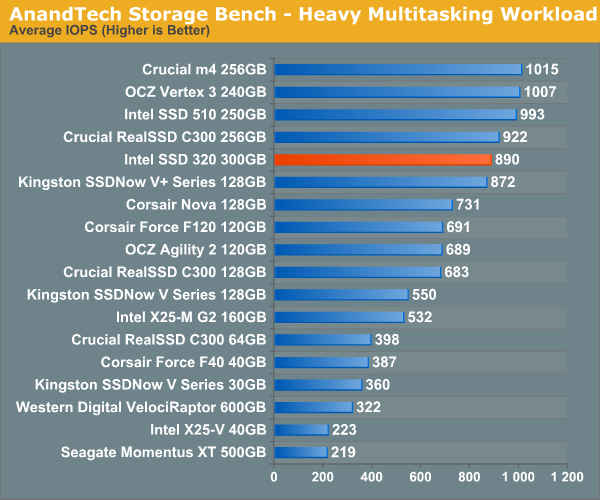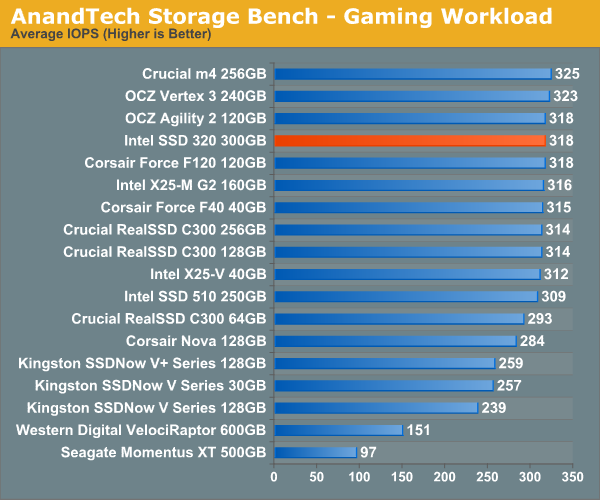The Intel SSD 320 Review: 25nm G3 is Finally Here
by Anand Lal Shimpi on March 28, 2011 11:08 AM EST- Posted in
- IT Computing
- Storage
- SSDs
- Intel
- Intel SSD 320
AnandTech Storage Bench 2010
To keep things consistent we've also included our older Storage Bench. Note that the old storage test system doesn't have a SATA 6Gbps controller, so we only have one result for the 6Gbps drives.
The first in our benchmark suite is a light/typical usage case. The Windows 7 system is loaded with Firefox, Office 2007 and Adobe Reader among other applications. With Firefox we browse web pages like Facebook, AnandTech, Digg and other sites. Outlook is also running and we use it to check emails, create and send a message with a PDF attachment. Adobe Reader is used to view some PDFs. Excel 2007 is used to create a spreadsheet, graphs and save the document. The same goes for Word 2007. We open and step through a presentation in PowerPoint 2007 received as an email attachment before saving it to the desktop. Finally we watch a bit of a Firefly episode in Windows Media Player 11.
There’s some level of multitasking going on here but it’s not unreasonable by any means. Generally the application tasks proceed linearly, with the exception of things like web browsing which may happen in between one of the other tasks.
The recording is played back on all of our drives here today. Remember that we’re isolating disk performance, all we’re doing is playing back every single disk access that happened in that ~5 minute period of usage. The light workload is composed of 37,501 reads and 20,268 writes. Over 30% of the IOs are 4KB, 11% are 16KB, 22% are 32KB and approximately 13% are 64KB in size. Less than 30% of the operations are absolutely sequential in nature. Average queue depth is 6.09 IOs.
The performance results are reported in average I/O Operations per Second (IOPS):

If we strip 6Gbps out of the equation completely, the SSD 320 does very well in our old light workload. You're looking at performance that's at the top of the pack from the mainstream offering.
If there’s a light usage case there’s bound to be a heavy one. In this test we have Microsoft Security Essentials running in the background with real time virus scanning enabled. We also perform a quick scan in the middle of the test. Firefox, Outlook, Excel, Word and Powerpoint are all used the same as they were in the light test. We add Photoshop CS4 to the mix, opening a bunch of 12MP images, editing them, then saving them as highly compressed JPGs for web publishing. Windows 7’s picture viewer is used to view a bunch of pictures on the hard drive. We use 7-zip to create and extract .7z archives. Downloading is also prominently featured in our heavy test; we download large files from the Internet during portions of the benchmark, as well as use uTorrent to grab a couple of torrents. Some of the applications in use are installed during the benchmark, Windows updates are also installed. Towards the end of the test we launch World of Warcraft, play for a few minutes, then delete the folder. This test also takes into account all of the disk accesses that happen while the OS is booting.
The benchmark is 22 minutes long and it consists of 128,895 read operations and 72,411 write operations. Roughly 44% of all IOs were sequential. Approximately 30% of all accesses were 4KB in size, 12% were 16KB in size, 14% were 32KB and 20% were 64KB. Average queue depth was 3.59.

Crank up the workload and the 320 falls a bit behind the rest of the competitors. Last year's heavy multitasking workload is nothing compared to what we introduced earlier this year, so it's still pretty light by comparison but it's clear for normal usage the 320's 3Gbps performance is quite good.
The gaming workload is made up of 75,206 read operations and only 4,592 write operations. Only 20% of the accesses are 4KB in size, nearly 40% are 64KB and 20% are 32KB. A whopping 69% of the IOs are sequential, meaning this is predominantly a sequential read benchmark. The average queue depth is 7.76 IOs.











194 Comments
View All Comments
piquadrat - Monday, March 28, 2011 - link
But is it true that on most of todays mobos and their bioses you can't set ATA password with more than 8 characters? I've read about this in many places.Anand says that passwords used to encrypt Intel's ssd are generated automatically during each secure erase. So user can define ATA pass only during secure erasing the drive? Every change of ATA pass require secure erase?
I thought that ATA pass is defined in bios and changed in bios. It means outside operating system and any soft toolbox Intel provides.
There are so many places in the net and even commertial companies that offer unlocking ATA secured deviced. Mostly they use non-official unlocking codes (manufacturers implemented them in firmware!!!). Can we trust that no such codes for 320 series surfaced in the near future? To sum up: is this secure on the enterprise level?
Is there any independent secure certificate Intel can give us at the moment?
overzealot - Tuesday, March 29, 2011 - link
The user doesn't supply a key - the drive generates one itself.The data can be accessed by ANY computer if you're accessing it by SATA, the point is to secure the data on the NAND (pro hackers attach a controller to the memory chips and read it directly).
Using previous SSD's, you could format the drive and just read the data straight off the chips. On these drives, erased data is inaccessible this way.
If you want secure data, use TrueCrypt or Bitlocker.
piquadrat - Tuesday, March 29, 2011 - link
Truecrypt and bitlocker are not suitable for ssds as they contradict internal wear-leveling mechanisms and kill performance of compression based controllers (like all SandForces).To sum up all this AES thing in intel's 320 is no different then in SF based drives (like Vertex 2)?
If keys are internal and not linked to ATA password in bios, when someone steal my drive (bios not supporting ATA pass or ATA pass bypassed/hacked) he has full access to it. So tell me:
Why anybody would BOTHER with "attaching a controller to memory chips and read it directly"? WHAT FOR? He has full access to drive without all that hassle.
overzealot - Thursday, March 31, 2011 - link
I'm sorry I wasn't clear.When you format or delete data from an SSD without internal encryption, data is still accessible directly from the chips. This encryption is to stop that.
Also, the performance of Sandforce drives does not drop handling compressed data! It just can't compress it any more, so really it's still throwing the exact same amount of data around!
You would see an improvement in throughput on drives that don't natively compress, but from the data I've seen they'd still be slower than Sandforce.
piquadrat - Saturday, April 2, 2011 - link
Just like in conventional HDDs, you can always do secure erase even without internal AES. It only adds max 1-2 to the live counter of each cell. On the other end how often does typical user need that kind of maintenance.Yes, they are dropping in performance vs typical statistical compression ratio. They drop from 250 to around 100 MB/s in writes.
Encrypting ssd drive with truecrypt means that effectively wear leveling algorithms see the drive as fully loaded. Spare area is used much more intensively. The drive starts to have problems with trimming and Garbage Collector. Additional empty partition required.
To sum up for Vertex2 with truecrypt and intel NI AES supported processor: read: 140MB/s, write: 70MB/s. 4K reduced by 50-60%. These are facts.
MeanBruce - Monday, March 28, 2011 - link
Intel's plan was to give us a little bump in performance every two years just to keep us happy and keep us buying and maybe go to 6GB/s by 2015 after their sata 2 drives had showed a slow yet incremental speed increase just enough to apease the masses. They never saw SandForce coming! I thought Intel would simply pull more performance out of their hat to meet the challenge, I never thought the hat would be empty!Drag0nFire - Monday, March 28, 2011 - link
Dear Anand,Given the switch to a new generation of NAND, any comments on the expected longevity of these new drives? How long will one last in a normal usage scenario?
Thanks,
--Jonathan
Drag0nFire - Monday, March 28, 2011 - link
Also, would it be possible to report the physical dimensions of the drive? I believe I may need a 2.5in drive with a height of 7mm for my next laptop, but it is difficult to find information on the height of SSDs.Thanks!
y.a.k - Tuesday, March 29, 2011 - link
Intel drives come with a spacer that makes them 9.5mm high. Removing this makes them 7mm high.B3an - Monday, March 28, 2011 - link
This has been commented on other recent SSD articles.